March 9, 2014 @ 6:00 AM
March brought Ash Wednesday this week, the beginning of Lent, and a time of joy - being present in the moment - a time for deep compassion - and of extraordinary giving to others, during the 40 days leading up to Easter. Tonight the clocks jump ahead, another sign that spring is not far behind. It's been a long snowy winter. The nor'easter continued to pile up snow, making life a challange for some people. The harsh weather has even taken its toll on wildlife, as recently reported in the Wall Street Journal. Diving ducks reportedly are having difficulty with frozen lakes and streams, getting hurt when mistaking the ice for water in hunting for food, and then unable to take flight off the slippery ice. Some animals hibernate during winter, yet others faced the heavy snow, impeding deer from foraging. Wild turkeys and phesants struggle to find food. White Snowy Owls have been seen in the far South in search of food. Opossums and other critters are contending with frosbite. We will soon find out if the severe weather has been kind to trees, bushes and shrubs.
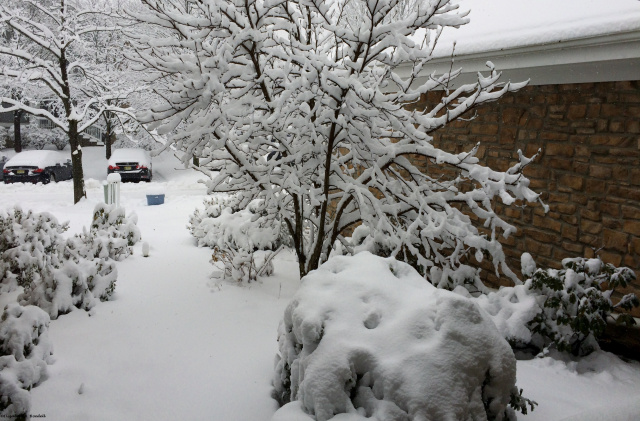
Nor'easter
A female eastern towhee bird was a surprise visitor at my birdfeeder for about two months. The female eastern towhee, also known as the rufous-sided towhee, is mostly light brown, with rusty red-brown sides and a white belly. White wing patches complement the long tail with its white tip. Slightly smaller and more slender than the American robin, it is 7–8 inches in size with a pointed bill. (The male is similar to the female, but is black, not brown.) When she is not at the feeder, you can spot the eastern towhee in the undergrowth at the edge of the woods.
Eastern Towhee
Year after year the same species appear at the birdfeeder to feast. Every so often there is a new arrival, but many are year-round residents. The birds are easy to identify by their unique traits, as well as color, size and distinctive call. I especially like watching the juveniles, they are so awkward and clumsy. This winter an American robin who decided not to migrate, but rather brave the northeast temperatures, stopped only to drink from the birdbath. The robin's diet consists of insects, fruit, worms and berries in winter.
American Robin
Other birds at the feeder include the Northern Cardinal, Blue Jay, Carolina Chickadee, Tufted-titmouse, Winter Wren, Morning Dove, Red-bellied Woodpecker, Downy Woodpecker, Common Crackle, Red-winged Blackbird, House Finch, American Goldfinch, White-throated Sparrow, White-breasted Nuthatch and European Starling. The winter brings the Dark-eyed Juncos and when they start to migrate north you know that spring is here.
After my daily morning workout at the gym, I take a few minutes to observe what is right outside my window and count all the birds I see for the Cornell Lab of Ornithology on my iPhone app. The Bird Log app is easy to use and so much fun. The Cornell Lab of Ornithology, in Ithaca New York, is a nonprofit organization that focuses on the study, appreciation and conservation of birds. The organization, part of Cornell University, does a marvelous job educating the public on bird life. If you haven't seen their bird cams, you are in for a treat. Check out their website. Another bird app on my iPhone, Larkwire Birdsong Master Birder, is a fun way of learning to identify bird sounds, using a game-based system. After you listen to four bird songs, you start the game and It plays one song at a time. When you think you have identified the bird song, you tap the bird icon to see if you answered correctly. It's not as easy as you would think.
The ground has been snow-covered for the last couple months, so I place plant trays filled with birdseed on the deck for the ground feeders. My two house mates, Pewter and Willow (who are brothers) have a front row seat by the French doors onto the deck to watch all the activity. Of course the free food also invites the squirrels who play with the cats, swatting at the glass that divides them. (Fortunately, only three squirrels visit this year. In the past, there have been as many as 18 around and about.) My kitchen overlooks the deck making it very convenient for me to continue recording bird sightings on the iPhone while working at the kitchen sink. I must admit that some days very little is accomplished. Watching bird antics is very mesmerizing and relaxing, and becomes a part of my daily meditation.
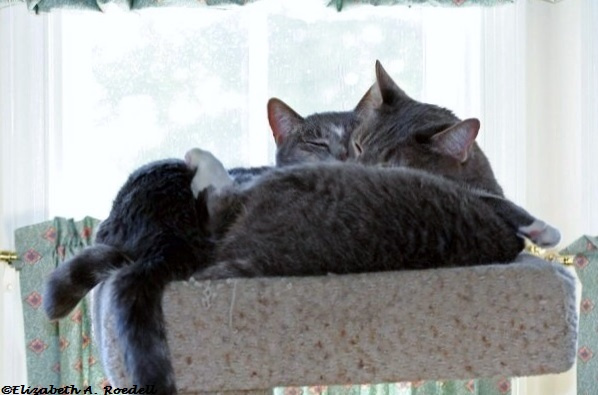
Willlow and Pewter
A few months ago I heard a loud bang at the back door. I looked out onto the deck and saw a male house finch laying still on the deck. He no doubt saw his reflection in the glass, thought it was clear sky and slammed into the door, as so often happens with birds. [Dangers during migration is a subject for another post.] After checking Google to see what to do, I gleaned that he probably sustained a concussion and would be dazed for a while. I gently picked up his warm body, put him in a shoebox and brought him into the garage. I kept an eye on him for a couple hours and finally to my delight, still wobbly, he flew into a nearby tree. I was glad I was able to lend a helping hand. The next day a similar male house finch was making a lot of noise, hanging on the screened window, to get my attention. Could it possibly be my new friend from the day before? Did he remember being inside my house? I like to think that he came back to say hello and thank me for my hospitality.
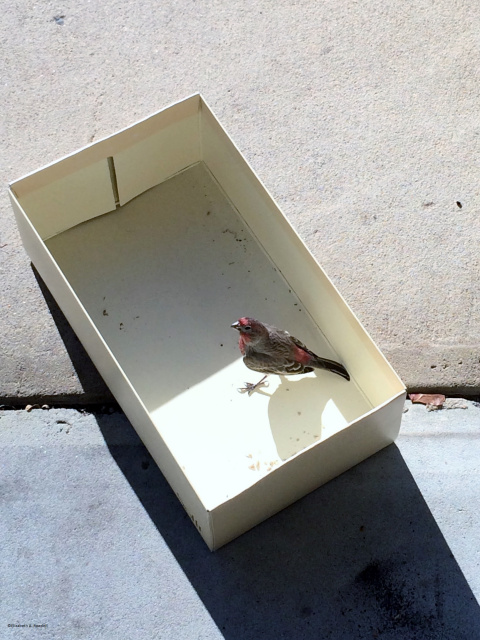
Dazed Male House Finch
This week the Wall Street Journal reported that Congress passed the first wilderness bill in five years. Protection was accorded to a small lakefront strip on Michigan's lower peninsula, Sleeping Bear Dunes National Lakeshore. This may only be a small win, but nevertheless, a step in the right direction towards conservation and preservation of wildlife. There are about two dozen bills pending in the House and Senate. The United States has a total of 110 million acres of wilderness since the Wilderness Act became law in 1964.
While I was writing this post, my friend Michele, who lives in Florida, sent me an email with a heart-warming story that her friend in Wisconsin sent her, and it is a perfect ending to this post and befittingly sums up my feelings and reason for writing this Blog. It's the story of a Brazilian musician, Jarbas Agnell, who found his inspiration in a bird photo. The song he composed, “Birds on the Wires”, can be viewed on YouTube. Thanks Michele.
"Nature is a revelation of God; Art is a revelation of man." - HENRY WADSWORTH LONGFELLOW (1807-1882)

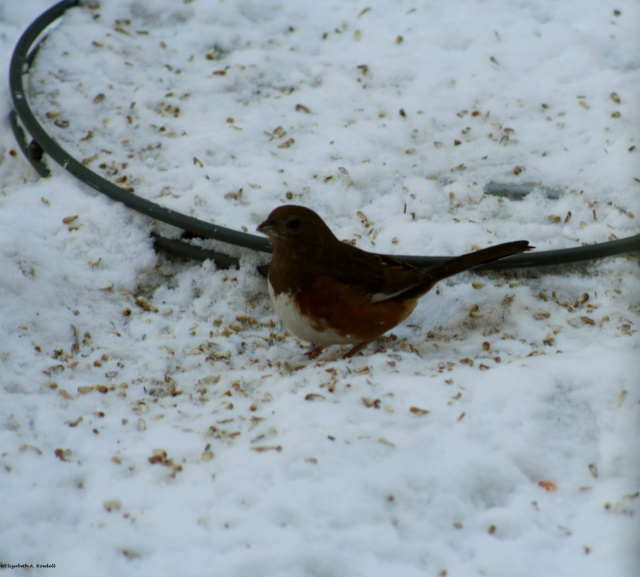
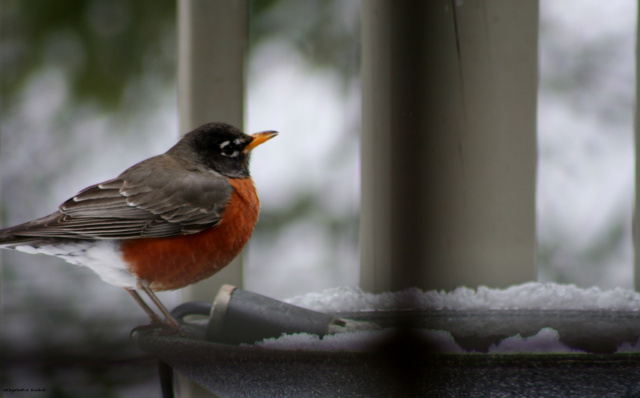



top school in greater noida premium school in greater noida